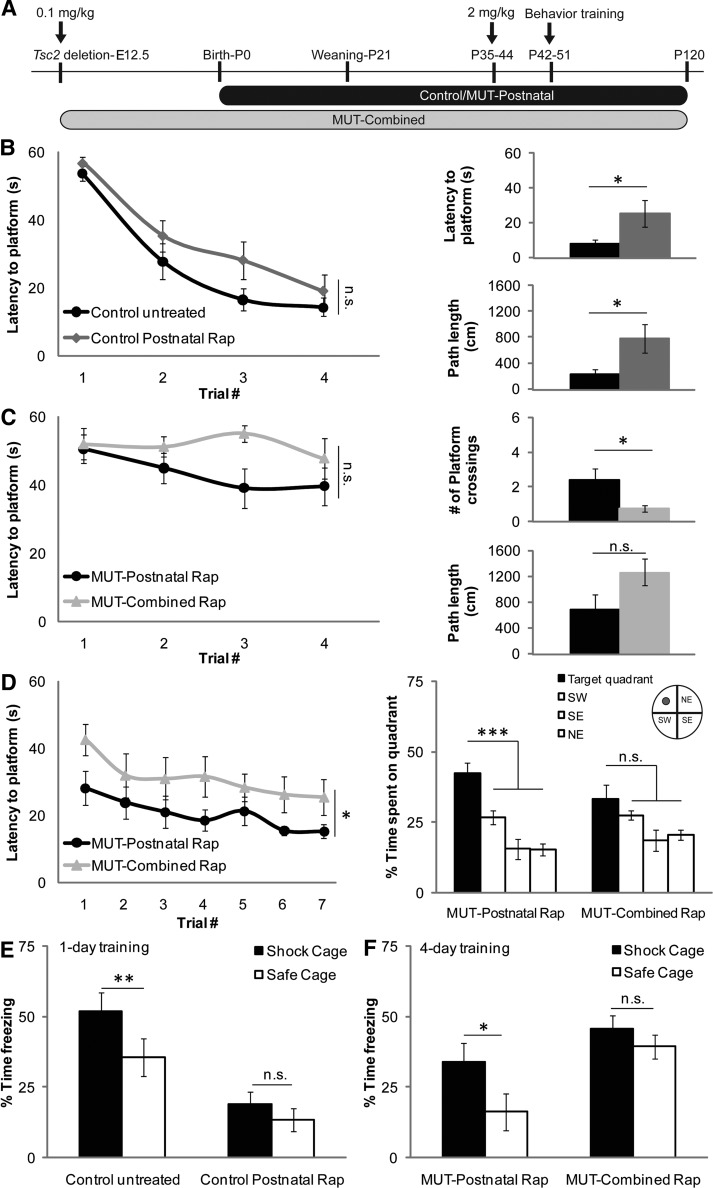Figure 5.
Effects of rapamycin treatments on learning and memory. (A) Rapamycin treatment regimens and timing for behavior testing. Animals were treated with 0.1 mg/kg rapamycin daily starting at E12.5 (combined group) or birth (postnatal group). Between P35 and P44, rapamycin dosing was changed to 2 mg/kg three times a week to maintain the health of the animals. Treatment continued throughout behavior testing and ended at P120. (B) Left panel: latency to platform during a 1-day MWM training protocol (n = 10 control untreated group, n = 10 control postnatal rapamycin group; two-way repeated-measures of ANOVA with treatment and trial number as between-subjects factors: F(1,18) = 2.95, P = 0.103). Right panels: latency to platform and path length traveled during probe trial 24 h after completion of training (two-tailed, unpaired student's t-test; latency to platform P = 0.04; path length P = 0.03) (C) Left panel: latency to platform during a 1-day MWM training protocol (n = 8 both groups; two-way repeated-measures of ANOVA with treatment and trial number as between-subjects factors: F(1,14) = 3.01, P = 0.105). Right panels: platform crossings and path length traveled during probe trial 24 h after completion of training (two-tailed, unpaired Student's t-test; platform crossings P = 0.036; path length P = 0.09) (D) Left panel: latency to platform during a 7-day MWM training protocol (n = 8 MUT-postnatal rapamycin group, n = 9 MUT-combined rapamycin group, two-way repeated-measures of ANOVA: group main effect F(1,15) = 5.271, P = 0.037). Right panel: quadrant preference during a probe trial 48h after training (one-way repeated-measures of ANOVA (MUT-postnatal group) and ANOVA on ranks (MUT-combined group) with quadrant as between-subjects factor: F(3,21) = 12.831, P< 0.001; Chi-square = 4.600, 3 d.f., P = 0.204). (E) Percent time spent freezing in shock cage or safe cage after 1 day of training in a context discrimination protocol (n = 10 both groups; two-tailed, paired Student's t-test P = 0.009 (control untreated); P = 0.085 (control postnatal rapamycin). (F) Percent time spent freezing in shock cage or safe cage after 4 days of training in a context discrimination protocol [n = 7 MUT-postnatal rapamycin group, n = 9 MUT-combined rapamycin group; two-tailed, paired student's t-test P = 0.014 (MUT-postnatal rapamycin group); P = 0.37 (MUT-combined rapamycin group)]. *P< 0.05, **P< 0.01, ***P< 0.001. Data represent means ± SEM.

